三种梯度算法:
1.批量梯度下降(BGD)
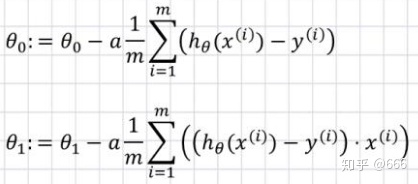
指在计算梯度下降的每一步中,我们都用到了所有的训练样本,在梯度下降中,在计算微积分时,我们需要进行求和运算。
2.随机梯度下降(SGD)

每次采用一个样本梯度下降
3.小批量梯度下降(MBGD)

每次迭代使用一个以上又不是全部的样本
代码实现
1.导包和保存图片
import numpy as np
#导入操作系统
import os
#画图
%matplotlib inline
import matplotlib.pyplot as plt
# 随即种子
np.random.seed (42)
# 保存图片
PROJECT_ROOT_DIR="."
MODEL_ID ="linear_nodels"
def save_fig(fig_id,tight_layout=True):
path=os.path.join(PROJECT_ROOT_DIR,"images",MODEL_ID,fig_id + ".png")
print ("Saving figure",fig_id)
plt.savefig(path,format = "png",dpi=300)
# 把讨厌的警告信息过滤掉
import warnings
warnings.filterwarnings(action="ignore",message="^internal gelsd")2.创建原始数据并画图
X = 2*np.random.rand(100,1)
y = 4 + 3 * X + np.random.randn(100,1)
plt.plot(X,y,"b.")
plt.xlabel("$x_1$",fontsize=18)
plt.ylabel("$y$",rotation=0,fontsize=18)
save_fig("generated_data_plot")
plt.show()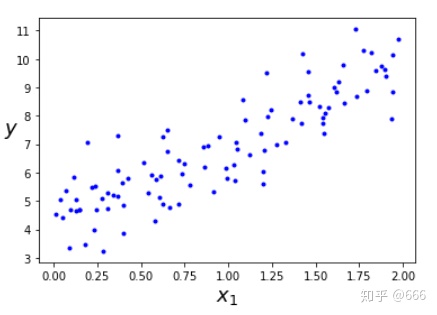
3.导包做预测
# 添加新特征
X_b = np.c_[np.ones((100,1)),X]
# 创建测试数据
X_new=np.array([[0],[2]])
X_new_b=np.c_[np.ones((2,1)),X_new]
# 从sklearn 包里导入线性回归方程
from sklearn.linear_model import LinearRegression
lin_reg=LinearRegression() #创建线性回归对象
lin_reg.fit(X,y) #拟合训练数据
lin_reg.intercept_,lin_reg.coef_ #输出截距,斜率
# 对测试集进行预测
lin_reg.predict(X_new)
4.用批量梯度下降求解线性回归
#alpha(学习率)
eta=0.1
#运行次数
n_iterations=1000
m=100
theta = np.random.randn(2,1)
for iteration in range(n_iterations):
gradients = 2/m * X_b.T.dot(X_b.dot(theta)-y)
theta=theta - eta*gradients定义函数
#用于只保存eta=0.1时的图像
theta_path_bgd=[]
def plot_gradient_descent(theta, eta, theta_path=None):
m=len(X_b)
# 对数据画散点图
plt.plot(X,y,"b.")
# 循环次数
n_iterations = 1000
for iteration in range(n_iterations):
if iteration < 10:
y_predict=X_new_b.dot(theta)
style = "r-"
plt.plot(X_new, y_predict, style)
# 梯度
gradients = 2/m * X_b.T.dot(X_b.dot(theta) - y)
# 更新theta
theta=theta-eta * gradients
if theta_path is not None:
theta_path.append(theta)
plt.xlabel("$x_1$",fontsize=18)
plt.axis([0,2,0,15])
plt.title(r"$eta = {}$".format(eta),fontsize=16)
画不同
np.random.seed(42)
theta = np.random.randn(2,1)
plt.figure(figsize=(10,4))
plt.subplot(131); plot_gradient_descent(theta, eta = 0.02)
plt.ylabel("$y$", rotation = 0, fontsize = 18)
plt.subplot(132); plot_gradient_descent(theta, eta=0.1,theta_path=theta_path_bgd)
plt.subplot(133); plot_gradient_descent(theta, eta = 0.5)
save_fig("gradient_descent_plot")
plt.show()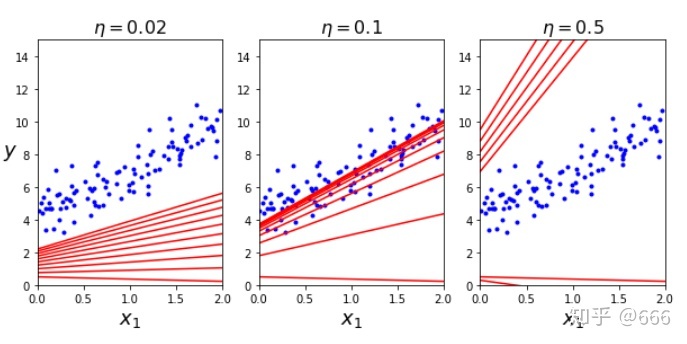
当
5.随机梯度下降
#存储每次 theta 更新的数据
theta_path_sgd=[]
m = len(X_b)
np.random.seed(42)
#遍历的次数
n_epochs = 50
theta = np.random.randn(2,1) #随即初始化
for epoch in range (n_epochs):
for i in range(m):
if epoch == 0 and i < 20:
y_predict = X_new_b.dot(theta)
style = "r-"
plt.plot(X_new, y_predict,style)
random_index = np.random.randint(m)
xi = X_b[random_index:random_index+1]
yi = y[random_index:random_index+1]
gradients = 2 * xi.T.dot(xi.dot(theta) - yi)
eta = 0.1
theta = theta - eta*gradients
theta_path_sgd.append(theta)
plt.plot(X, y, "b.")
plt.xlabel("$x_1$",fontsize = 18)
plt.ylabel("$y$", rotation = 0, fontsize=18)
plt.axis([0,2,0,15])
save_fig("sgd_plot")
plt.show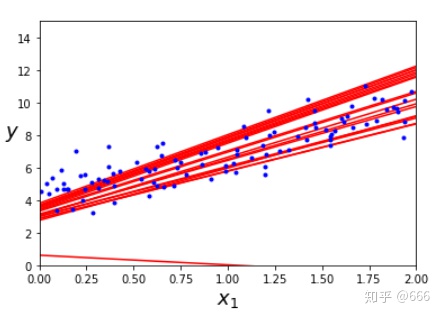
调用写好的包
from sklearn.linear_model import SGDRegressor
sgd_reg = SGDRegressor(max_iter=5000,tol = -np.infty, penalty = None,eta0 = 0.1,random_state=42)
sgd_reg.fit(X, y.ravel())
sgd_reg.intercept_,sgd_reg.coef_
6.小批量梯度算法
定义函数:
theta_path_mgd = []
n_iterations = 50
minibatch_size = 20
np.random.seed(42)
theta = np.random.randn(2,1)
for epoch in range(n_iterations):
# 将数据打乱
shuffled_indices = np.random.permutation(m)
X_b_shuffled = X_b[shuffled_indices]
y_shuffled = y[shuffled_indices]
for i in range(0, m, minibatch_size):
xi = X_b_shuffled[i:i+minibatch_size]
yi = y_shuffled[i:i+minibatch_size]
gradients = 2/minibatch_size * xi.T.dot(xi.dot(theta) - yi)
eta = 0.1
theta = theta - eta * gradients
theta_path_mgd.append(theta)7.总结三种方式并画图
theta_path_bgd = np.array(theta_path_bgd)
theta_path_sgd = np.array(theta_path_sgd)
theta_path_mgd = np.array(theta_path_mgd)
plt.figure(figsize=(7,4))
plt.plot(theta_path_sgd[:,0], theta_path_sgd[:,1], "r-s", linewidth=1, label="Stochastic")
plt.plot(theta_path_mgd[:,0], theta_path_mgd[:,1], "g-+", linewidth=2, label="Mini-batch")
plt.plot(theta_path_bgd[:,0], theta_path_bgd[:,1], "b-o", linewidth=3, label="Batch")
plt.legend(loc = "upper left",fontsize=16)
plt.xlabel(r"$theta_0$",fontsize=20)
plt.ylabel(r"$theta_1$",fontsize=20,rotation=0)
plt.axis([2.5,4.5,2.3,3.9])
save_fig("gradient_descent_plaths_plot")
plt.show()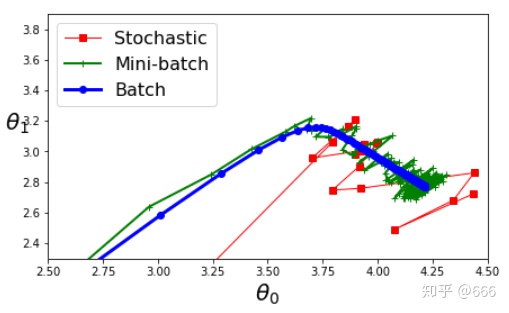
小批量梯度下降的算法比较好,它集中了批量梯度下降和随机梯度下降的优点。使多个样本相比SGD提高了梯度估计的精度




















 133
133











 被折叠的 条评论
为什么被折叠?
被折叠的 条评论
为什么被折叠?








